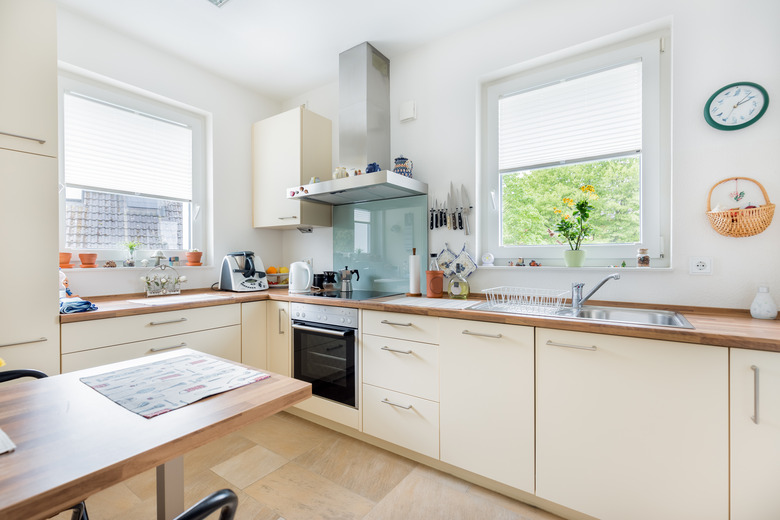Height Of Kitchen Windows
Wide windows unencumbered by curtains bring light into a kitchen, opening the room to the outdoors. But wall cabinets and large appliances can make it hard to open up a kitchen to light. When designing a kitchen for new construction or adding openings during a major remodel, consider floor-to-ceiling windows or ones that rest right at the top of your kitchen counter. Traditional kitchens with a backsplash and window aprons have the highest windows, but with a little pre-planning, you can determine the best kitchen window height to take full advantage of all available space.
Window Size Above Kitchen Sink
Window Size Above Kitchen Sink
You spend a lot of time in your kitchen standing at the sink, whether you're washing dishes, rinsing vegetables, filling the kettle or simply cleaning your hands. If possible, plan for a large window size above the kitchen sink. Having windows begin just above the counter creates an illusion that your space and the outdoors are connected.
To do this, you will need to know the height of your cabinets — traditionally 34 1/2 inches — and the thickness of your countertop — usually 1 1/2 inches. The window height, therefore, should be set at 37 inches.
Windows Below the Countertop
Windows Below the Countertop
Kitchen windows that let in natural light not only enhance the overall aesthetic and atmosphere of your space, but also give you the opportunity to have an indoor herb garden. To grow culinary and decorative plants in your kitchen without blocking any light, drop your window slightly lower than your counter, add a slate windowsill and fill the area with potted plants. This set-up will make it look as though the plants are growing up from behind your sink.
Windows Above the Backsplash
Windows Above the Backsplash
If you are planning to add a backsplash behind your counter, you will need to consider the height of the backsplash for window placement. The backsplash usually is at least 4 inches high. If the cabinets are 34 1/2 inches high and the countertop adds 1 1/2 inches, increase the overall number by 4 inches for the backsplash, making the minimum height for your window 41 inches. For a traditional look, with a sill and an apron at the bottom of the window, add another 4 to 6 inches to the height to determine the standard kitchen window size.
Floor-to-Ceiling Kitchen Windows
Floor-to-Ceiling Kitchen Windows
Traditionally, windows were placed to match the height of the door frames — 6 feet 8 inches. Whatever space was available, below that and above the counter, was used as the window area. If you are lucky enough to have the space and a beautiful view, opt for floor-to-ceiling windows to bring the most light into your room. There's no rule that says your windows need to be at the same height as your doors — and a window that skims the ceiling and floor also gives you the best view possible.
Skylight Kitchen Windows
Skylight Kitchen Windows
If your kitchen doesn't have much wall space to spare, you can still bring in plenty of natural light with a skylight. A "sky tunnel" brings light into your kitchen without requiring a large footprint for installation, but you can also choose a larger and more traditional skylight to expose as much of the sky and sunshine as possible.
Other Important Considerations for Kitchen Windows
Other Important Considerations for Kitchen Windows
Once you've determined the ideal kitchen window height, don't forget to think about finding a window style that's easy to open. You'll be leaning across a countertop to reach the window, which can make it difficult to get leverage to open some types of windows, like double-hung windows. You can also visit the U.S. Energy Department website to discover energy-efficient options that will allow you to save money on your heating and cooling bill while enjoying plenty of natural light in your kitchen.
